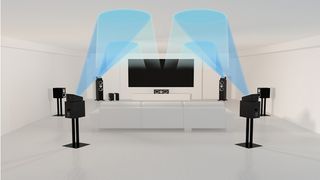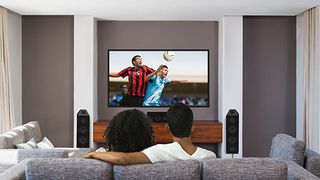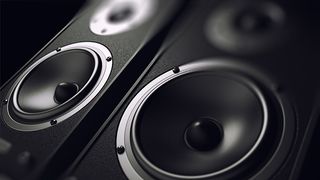DTS:X vs Dolby Atmos vs DTS Play-Fi: surround sound and multi-room explained
Everything you need to know about next-gen audio

Home audio is evolving. Both surround sound and multi-room technologies have taken a giant leap forwards with three technologies in recent years: DTS:X, Dolby Atmos and DTS Play-Fi.
The first two are surround sound technologies that promise to make your movies and TV shows more immersive than ever, while DTS Play-Fi is a manufacturer-agnostic multi-room platform that can link devices of all kinds in many rooms throughout the house.
You may well have heard of one, two or all three of these technologies. But do you really know what they mean, how they work, and how they differ from each other? Prick up your ears, as we explain all.
- Here are the best 4K Blu-ray players you can buy
What is DTS:X? Making next-gen surround sound open-source
Like its rival Dolby Atmos, DTS:X is an object-based audio format that can place sound in more specific locations around the room than with generic surround sound. Unlike its rival, though, it started life in home cinema devices (in 2015) before being implemented in cinemas themselves.
The aim is the same as Dolby Atmos: to let sound move around the room in a more realistic manner to match the action on-screen, creating more immersive cinematic experiences. But the way it works is different.
Instead of requiring extra speakers (like Dolby Atmos), it works with standard surround sound systems. So chances are the set-up you have at home – be it 5.1 or 7.1 – is compatible. But DTS:X can support much more extensive systems too, comprising up to 32 speaker locations and up to an 11.2-channel system.
DTS:X uses an open source Multi-Dimensional Audio (MDA) platform. So just like Android, any manufacturer can create a system that will be compatible with DTS:X with no special permission required.
Get the best Black Friday deals direct to your inbox, plus news, reviews, and more.
Sign up to be the first to know about unmissable Black Friday deals on top tech, plus get all your favorite TechRadar content.
What is Dolby Atmos? Bringing the cinema experience home
The end result of Dolby Atmos is very similar to DTS:X, but the technology itself is quite different.
For a start, Atmos started life in cinemas, only later coming to home cinema products like speakers and soundbars. Both Atmos and DTS:X are object-based surround sound technologies, but Atmos puts more emphasis on height – so much so that Dolby recommends you install ceiling speakers to get the full benefit.
Obviously that’s not practical for most people. But thankfully there are Dolby Atmos-certified speakers, TVs and soundbars with upward-firing drivers to bounce sound off the ceiling. The result? You’ll be enveloped in a ‘bubble’ of sound, with actions like a helicopter flying overhead or bullets whizzing past your ears sounding more lifelike than ever.
Atmos speakers also count towards the nomenclature of your system. So a 5.1 system (made up of five satellites and one subwoofer) with four Dolby Atmos speakers would be referred to as 5.1.4. 7.1.4 is the reference set-up for Dolby Atmos – in other words, the tech runs natively on a set-up comprising seven satellites, one sub and four Atmos speakers.
For a more extensive look at Dolby Atmos, check out our full guide.

DTS:X vs Dolby Atmos: which is better?
This is the real question. On paper, DTS:X has the edge in terms of sound quality because it supports higher bit rates.
It’s not that simple, however. Dolby claims its codecs are more efficient than DTS’, and hence sound comparable or even better at a lower bit rate. Regardless, there’s a lot more to consider than just pure audio performance.
DTS:X lets you manually adjust sound objects, so you can turn up the volume of voices, say. That will make hushed dialogue easier to decipher, which is something many of us have longed for during a Hollywood blockbuster.
DTS:X also doesn’t have any official speaker requirements, so as long as yours are compatible (portable speakers with a built-in battery need not apply), you can arrange them pretty much however you like. Having said that, many find Dolby Atmos’ requirements a useful guide on how to get the most from the technology.

Dolby Atmos is also more commonly found than DTS:X, despite around 90 percent of the home AV market supporting the latter. Both Netflix and Amazon Prime Video support Atmos, rather than DTS:X, as do some TV broadcast channels like BT Sport Ultimate. Both Atmos and DTS:X around found on a host of DVDs and Blu-rays, if you’re watching on a 4K Blu-ray player too.
So, in the war between DTS:X and Dolby Atmos, there’s no clear winner. The good news is, you don’t necessarily have to choose between the two. Plenty of AV receivers and surround sound systems support both technologies, so – as long as you have the right source content – you can enjoy high-quality audio whichever codec is used.
What is DTS Play-Fi? Multi-room without the commitment
If you want to link unrelated audio kit across different rooms of the house to create a multi-room effect, DTS Play-Fi can help. It’s a wireless audio platform that’s licensed to hi-fi brands. It means that instead of buying all your audio gear from one manufacturer like Sonos or Bluesound, you can wirelessly link devices made by lots of different manufacturers. These are mostly ‘serious’ hi-fi brands like McIntosh, Onkyo, Arcam, Klipsch, Polk and Thiel.
Compatible devices include wireless speakers, stereo systems, AV receivers, preamps, streamers, media servers and more. You can control them all using the Play-Fi app on your Android or iOS device, Amazon Fire tablet or computer.
The app supports all the major streaming services (Spotify, Tidal, Amazon Music, etc), with the notable exception of Apple Music – though some Play-Fi-compatible products do support Apple’s AirPlay 2 wireless tech.

DTS Play-Fi supports MP3, M4A, AAC, FLAC, WAV and AIFF files up to 16bit/48kHz resolution without compression. But if you choose, you can stream higher resolution files than that – using the service’s Critical Listening mode, you can stream up to 24bit/192kHz (i.e. high resolution) tunes across your wi-fi network. Though those files will be pretty large, so you might want to use a wired connection to avoid the playback stuttering like Grandmaster Melle Mel.
So how many devices can you add to your home network? As many as you like, though DTS recommends a maximum of 32 to avoid performance issues. And up to 16 Play-Fi devices can play the same song. Imagine: Elton John’s Rocketman following you around the house. Terrifying.
You can also control Play-Fi using your voice through Amazon’s Alexa or Apple’s Siri voice assistants.
- Best home theater system: creating the perfect home cinema setup
Joe has been writing about tech for 17 years, first on staff at T3 magazine, then in a freelance capacity for Stuff, The Sunday Times Travel Magazine, Men's Health, GQ, The Mirror, Trusted Reviews, TechRadar and many more (including What Hi-Fi?). His specialities include all things mobile, headphones and speakers that he can't justifying spending money on.
Most Popular


